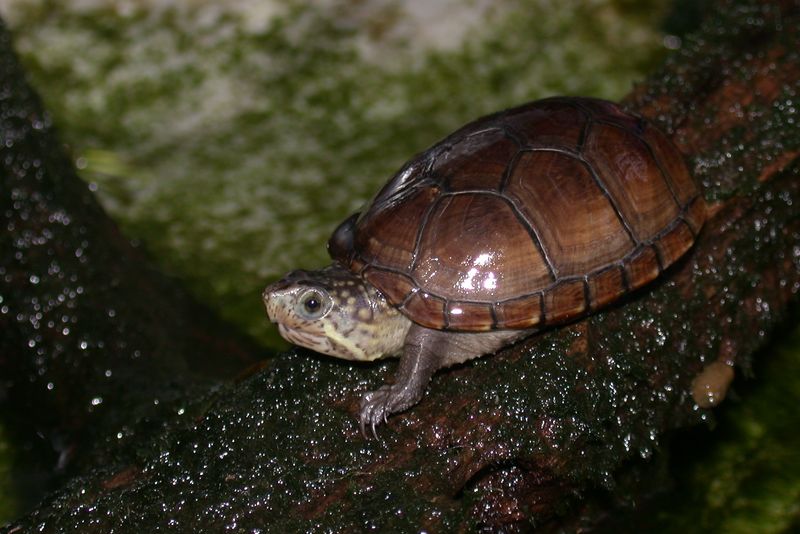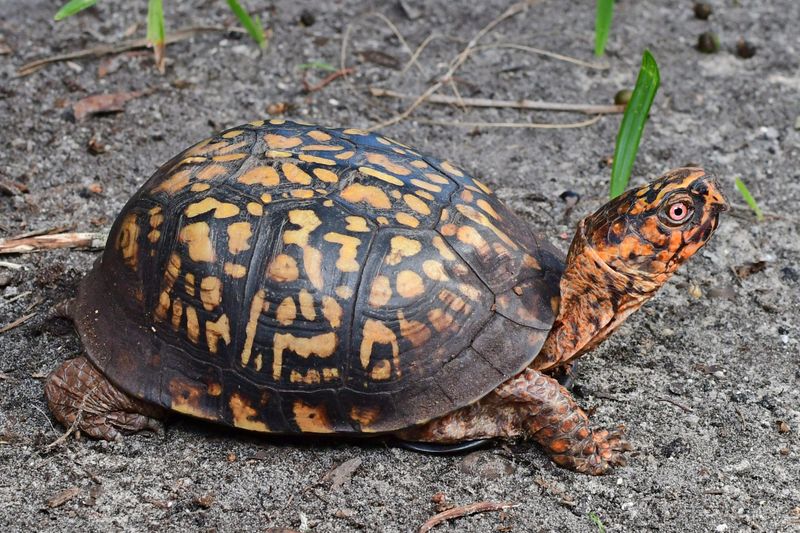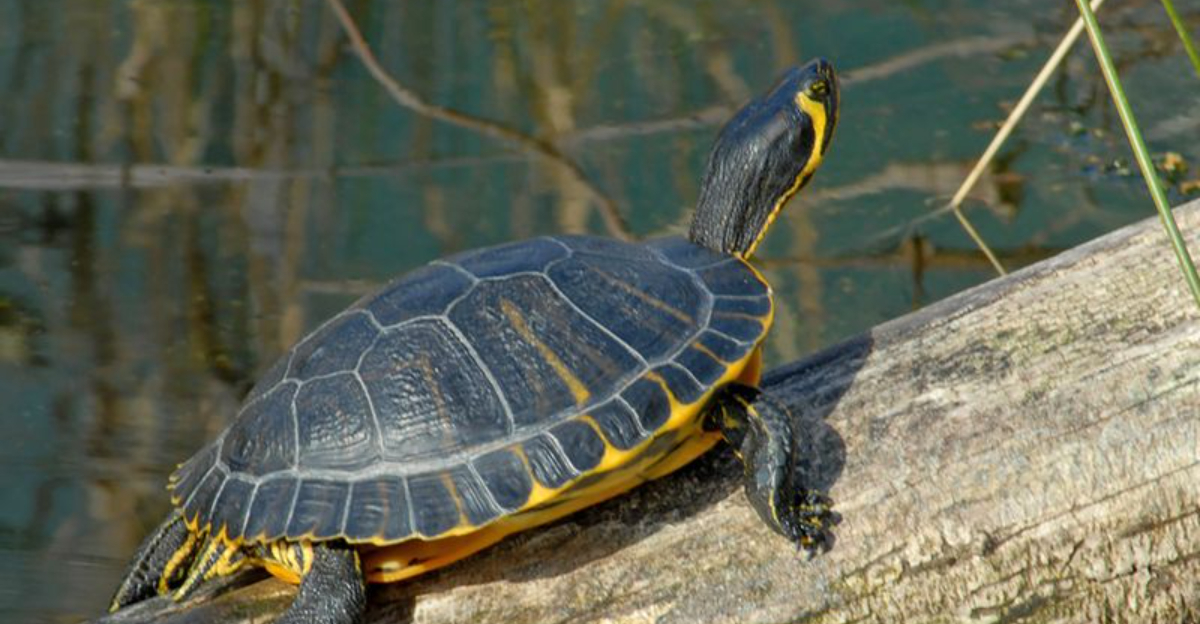Sink into the misty wetlands of South Carolina, and you’ll uncover seven turtle species so fascinating they’ll make you reconsider everything you thought about shelled reptiles.
From pocket-sized mud turtles folding themselves into unbreakable mini-fortresses to glamorous spotted turtles that glimmer like living jewels, these aren’t your average pond dwellers—they’re nature’s hidden wonders.
Let my wildlife photography journey through cypress swamps and marshes guide you into their secret world. Ready to be amazed at what’s hiding beneath the reeds?
1. The Mysterious Eastern Mud Turtle

Stumbling upon my first Eastern Mud Turtle was like finding buried treasure! These chocolate-brown shelled critters barely grow larger than your smartphone, making them adorably pocket-sized compared to their cousins.
What makes these little guys truly special is their ninja-like ability to completely seal themselves inside their shells when danger approaches. No head, no tail, no feet – just a tightly closed fortress of protection!
During one particularly muggy July morning, I watched in amazement as a mud turtle buried itself completely in the soft muck, leaving just two tiny nostrils exposed for breathing. Talk about the ultimate game of hide-and-seek champions of the wetland world!
2. The Speedy Chicken Turtle

Despite their comical name, Chicken Turtles aren’t the least bit cowardly! The first time I spotted one zipping through the water, I couldn’t believe my eyes – these speedsters can outswim practically any other turtle in South Carolina’s wetlands.
Their extraordinarily long necks (which supposedly reminded early settlers of a chicken’s neck) allow them to snatch up small fish with lightning-fast precision. The bold yellow stripes decorating their faces and limbs make them look like tiny underwater racecar drivers.
Last summer, I watched a Chicken Turtle devour an entire school of minnows in under three minutes. Their appetites are as impressive as their swimming abilities, and they’re not picky eaters either!
3. The Jewel-Like Spotted Turtle

Holy shell patterns, Batman! The Spotted Turtle looks like it’s wearing a custom-designed cape of yellow polka dots against a glossy black background. Each turtle sports a unique pattern, like a fingerprint made of sunshine!
These little gems are becoming increasingly rare finds. My heart practically jumped out of my chest when I finally photographed one basking on a log after three years of searching South Carolina’s wetlands.
Sadly, their stunning appearance has made them targets for the illegal pet trade. Conservation efforts are now in full swing to protect these living jewels from disappearing forever. If you’re lucky enough to spot one in the wild, consider it nature’s version of finding a four-leaf clover!
4. The Understated Striped Mud Turtle

Blink and you’ll miss ’em! Striped Mud Turtles are the masters of camouflage in South Carolina’s murky wetlands. Their earth-toned shells, decorated with subtle yellow stripes, blend perfectly with the muddy bottoms they call home.
My favorite thing about these little ninjas? Their incredible sense of smell! Once I watched a Striped Mud Turtle follow the scent trail of a crayfish for over twenty feet through cloudy water. Nature’s bloodhounds with shells!
They’re also surprisingly feisty for their small size. When startled, they’ll release a musky odor that smells like old gym socks left in a locker for a month. Trust me—I learned this the hard way when trying to photograph one up close. My camera bag has never been the same!
5. The Sunbathing Yellow-Bellied Slider

Party animals of the turtle world! Yellow-bellied Sliders are the social butterflies you’ll spot stacked like pancakes on logs, soaking up sunshine with their buddies. My record sighting was seventeen sliders piled on one fallen cypress—a genuine turtle tower!
Their bright yellow undersides flash like warning signs when they’re swimming, creating a beautiful contrast against their olive-green shells. Young sliders sport emerald patterns that would make jewelry designers jealous.
Fun fact: these turtles got their “slider” name from their hilarious escape method. When startled, they’ll literally slide off their basking spots and plop into the water faster than you can say “turtle.” I’ve spent hours trying to quietly approach them for photos, only to witness the domino effect as one spooked slider sends the whole group splashing!
6. The Grumpy Loggerhead Musk Turtle

If turtles had personality contests, the Loggerhead Musk would win “Most Likely to Need Anger Management.” These pint-sized grouches pack serious attitude! The first one I encountered tried to bite my camera strap with surprising determination.
Their oversized heads (hence the “loggerhead” name) house powerful jaw muscles that can deliver a surprisingly painful nip. Two barbels under their chins look like tiny catfish whiskers, giving them an almost comical appearance despite their cranky demeanor.
When feeling threatened, these turtles release a defensive musk smell so potent it could clear a restaurant. During a guided wetland tour, I accidentally startled one, and the resulting odor had my entire group pinching their noses for the next half hour. Small but mighty indeed!
7. The Adaptable Eastern Box Turtle

Technically homebodies rather than pure wetland dwellers, Eastern Box Turtles deserve honorable mention as South Carolina’s wetland visitors. These terrestrial turtles with high-domed shells often wander into wetland edges for a cool dip during summer heat waves.
Their shells feature intricate patterns in amber, chocolate, and cream that remind me of abstract paintings. Each turtle’s design is completely unique—nature’s own fingerprinting system! During one particularly dry spell, I watched an Eastern Box Turtle soak in a shallow marsh puddle for nearly two hours.
Unlike their aquatic cousins, these turtles can completely close their hinged shells, transforming into impenetrable fortresses when threatened. The satisfying “click” sound of a box turtle closing up shop is something I’ll never forget from my childhood explorations in Carolina woodlands.
